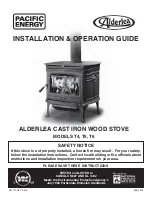
INSTALLATION AND USE MANUAL
Chapter 2
page
8
Theoretic notions for installation
Technical service - MCZ
S.p.A. all rights reserved - Reproduction prohibited
IMPORTANT!
•
The stove must be installed and assembled by
qualified personnel.
•
The stove must be connected to a chimney flue or
other vertical smoke stack that can discharge
smoke at the highest point of the house.
•
The stove must be connected to the internal or
external chimney flue or smoke stack, according
to current regulations.
•
Smoke is generated from burning wood and,
therefore, may dirty adjacent or nearby walls.
•
Before installing the stove, drill a hole for the
external air outlet.
2.3.
EXTERNAL AIR OUTLET
The room where the stove is installed must have at least as much air as
requested by normal device combustions and by room ventilation. They
may occur through permanent apertures in the room walls that lead
directly outdoors or ventilated rooms according to UNI 10683 REV.
For this purpose, drill a hole with minimum 150 cm² free section near
the stove (15 cm diameter or a 10x15cm rectangle), protected by an
indoor and outdoor grill.
The air intake must also:
directly communicate with the installation room
•
be protected by a grill, made of metallic anti-insect mesh or a
suitable protection as long as it does not reduce the minimum
section.
•
be installed so as to avoid obstruction
•
in the event of conduits, up to 3.5 ml, increase the section by
about 5% while increased by 15% for larger measurements.
Remember that the ventilation grill always have a cm
2
useful
section on one side. When selecting the grill and hole
dimension, make sure the useful grill section is greater than
or equal to the section required by MCZ for product
operations.
Connecting the air outlet directly to the stove is not
mandatory but the abovementioned section must guarantee
about 50 m³/h of air. See regulation UNI10683 REV.
IMPORTANT!
Air flow may also be obtained from a room adjacent
to the installation room as long as this flow is free
through
permanent
apertures
that
directly
communicate with the outdoors; avoid air outlets
connecting with heating units, garages, kitchens or
bathrooms.









































